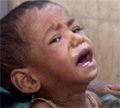
The recent report of some NGOs citing the death of over 125 children less than six years of age due to malnutrition in the tribal belt of Madhya Pradesh is certainly an alarming aspect that the government needs to address at the earliest possible. Though the state government is in denial mode terming the death caused due to some severe diseases, a comprehensive plan to curb it is yet to be formulated.
Madhya Pradesh being among the state with highest child mortality rate in India has been served with several programmes including the Bal Sanjeevani campaign in operation from 2001, but that seems to be dry down under corruption. As per reports, as many as 80 infants have died in two tribal blocks of Satna and Khandwa districts suffering from various diseases as a result of undernutrition.
The death of such a large number of children in the past five months certainly indicates the failure of various ongoing government programmes including National Health Mission, National Nutrition Mission, National Rural Employment Guarantee Scheme and foremost one is the Integrated Child Development Services Scheme (ICDSS).
India’s Integrated Child Development Services (ICDS), a centrally sponsored scheme, which first came into force in 1975 to improve the nutritional and health status of children especially of rural, tribal and slum areas is yet to achieve the same.
Despite making child nutrition a central concept in national policies, the prevalence of underweight children in India is highest in the world. Again even though it has been concentrated to some particular regions and sections only, the respective administration is yet to come up with some well-planned implementation strategy to ensure the same.
According to a UNICEF report poor nutrition has now become a global epidemic contributing to more than one-third of the over all 9.2 million under-five child deaths. In a recent statement, the UN organisation has stated that though the child deaths has declined by 27 percent over the last 17 years but there are an estimated 148 million undernourished children in the developing world; India constitutes a large portion.
As far as India is concerned, lack of ‘political will’ results with no effective, efficient and equitable implementation of various programmes. Furthermore, socio-economic, demographic and geographic inequalities in undernutrition require more specific approach in nutrition policy to address the whole.
There is an urgent need to review the entire child development programme making them more effective in terms of quality of service delivery, reaching more and more villages, better target in age group, community participation and a better monitoring service. Or else, a double digit economic growth is unlikely to lower the number of malnutrition cases substantially with regards to the Millennium Development Goal.
|
|
Read More: Satna | Bangalore Rural


Comments: